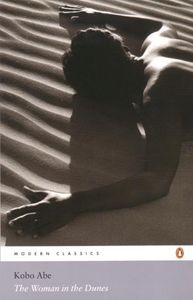 The Woman in the Dunes by Kobo Abe (1962).
The Woman in the Dunes by Kobo Abe (1962).
Appreciation of Kobo Abe’s The Woman in the Dunes by Kathryn Harrison
One day in August a man disappeared. The man was an entomologist and had set out into the desert with a canteen of water and a pack filled with the tools he used to collect specimens. It was his hope to discover an as yet unknown species of insect that lived in the sand dunes. Were he to find one, then he would be promised a kind of immortality: his name would be recorded and forever linked to the taxonomic identification of the bug—his bug.
Shifting sands, isolation, a quixotic attempt to defy mortal limits: even before the hero of Kobo Abe’s The Woman in the Dunes has missed the last bus out of the desert, the reader knows he is lost to an existential quest. Abe, trained as a medical doctor, writes as a clinician, dispassionately and with exactitude. In the dunes his hero, Niki Jumpei, falls captive to the enigmatic woman from whom he seeks shelter for a night. Having descended into the sand pit where the woman lives, Jumpei discovers that there’s no way out; he’s trapped in a sinister village where each citizen becomes Sisyphus. Every day Jumpei must join the inhabitants in their necessary work: shoveling away the sand that threatens to bury them and their homes.
"The Woman in the Dunes" transcends the form of allegory—often lifeless and didactic—to engage its readers to the point of discomfort. It’s a claustrophobic novel, subjecting us to Jumpei’s mounting panic as he begins to suspect that he will never leave the sand pit, that meaningless striving is his, and our, inescapable fate.
Total Points: 10 (KHarr 10)